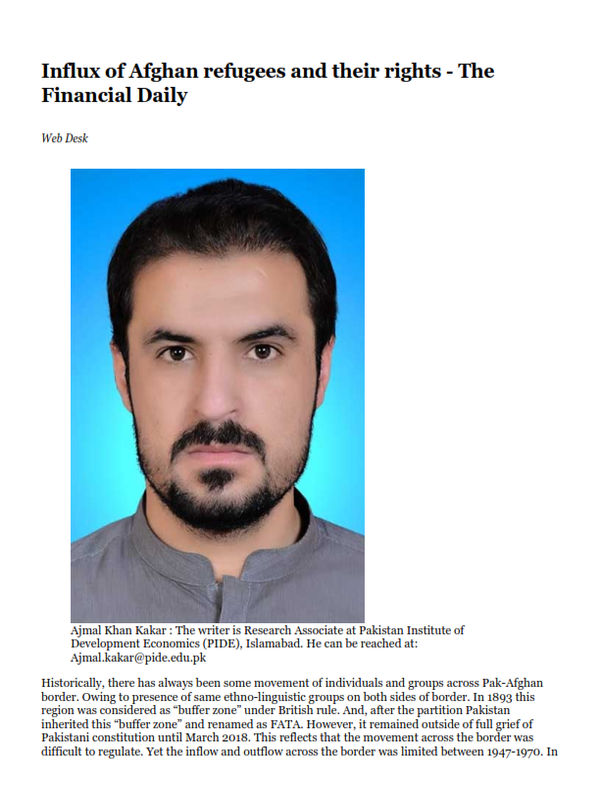
Pakistan Institute of Development Economics
- Home
Our Portals
MenuMenuMenuMenuMenuMenuMenu - ResearchMenuMenuMenuMenuMenuMenuMenu
- Discourse
- The PDR
- Our Researchers
- Academics
- Degree Verification
- Thesis Portal
- Our Portals
Influx of Afghan refugees and their rights
Historically, there has always been some movement of individuals and groups across Pak-Afghan border. Owing to presence of same ethno-linguistic groups on both sides of border. In 1893 this region was considered as “buffer zone” under British rule. And, after the partition Pakistan inherited this “buffer zone” and renamed as FATA. However, it remained outside of full grief of Pakistani constitution until March 2018. This reflects that the movement across the border was difficult to regulate. Yet the inflow and outflow across the border was limited between 1947-1970. In fact, influx of Afghan refugees augmented since 1970s when her political situations changed.
Afghanistan’s political conditions changed in 1973 when, Daoud Khan along with military support overthrown kingship of Zahir Shah. And, this coup was followed by aggressive socialist inspired state centralization. Consequently, thousand of Afghans migrated to Pakistan. The state centralization narrative exacerbated with rise of communist People’s Democratic Party of Afghanistan (PDPA) in 1970s. In April 1978, PDPA took over and killed Daoud Khan in “Sure Revelation” but, the masses strongly resisted across the country. However, this led to more spontaneous movement of individual and groups to Pakistan.
By end of 1979 there were more than 400,000 Afghan refugees in Pakistan and PDPA requested support from Soviet Union to crush the resistance they faced. Soviet Union started war in Afghanistan which resulted in humanitarian crisis. Consequently, At the end of war there were four to five million Afghans sought refuge in Pakistan. At that time Pakistan warmly welcomed Afghan refugees owing to her political interest.
Unfortunately, the end of Soviet-Afghan War gave birth to civil war in Afghanistan. As during 1989, different factions of Mujahedeen returned to Afghanistan and made competing climes to power. Mujahideen forced PDPA out of power in 1992, and persecuted PDAP civil servants. The result was a new wave of immigrants to Pakistan.
Finally, it was ” War on Terror ” which compelled Afghan refugees to seek refuge in Pakistan. In October 2001, the US invaded Afghanistan after holding Taliban government responsible for terrorist attacks of September 11. Surprisingly, this time Pakistan under the Presidentship of Pervez Musharraf allied with U.S and tried to distance itself from Taliban, though, Pakistan had clear cut links with Taliban. In fact, they were residing in Pakistan.
Currently Pakistan host some 2.4 million Afghan refugees. But it was not a party to either 1951 Convention related to the status of refugees or its 1967 Protocol. Moreover, Pakistan has no official refugee law. Regardless, 2003 Tripartite agreement among Pakistan, Afghanistan and UNHCR bound to facilitate repatriation and ensure refugees rights and privileges. In addition to, Pakistan is bound by norms of customary international law related to the treatment and protection of refugees, including principle of non-refoulement. Similarly, Pakistan has ratified other major human rights conventions which provide political, economic, civic and social rights to everyone residing within its territory, including refugees.
On the other hand, most of the refugees are not entitled to citizenship. Even the status of their children born in Pakistan remains ambiguous. They have limited access to public schools, health care and courts. Majority of the refugees live below or near to poverty line, residing in slums/camps. And, have only access to informal sector for earning livelihood. These conditions are further augmented by social-xenophobia, adverse treatment and discrimination at the hands of police, who often arrest refugees for alleged violations of The Foreigners Act 1946. Even these vulnerable population have been ignored during the first wave of COVID-19, as government lunched the “Ehsaas Program” in order to provide financial relief to its citizen but no such measures were taken for Afghan refugees. Same is true in its second wave.
To sum up, Pakistan cannot afford to neglect its refugee population. And, need to rethink about its policies towards Afghan refugees. Especially about the status of refugees living in Pakistan for more than fifty years. The government of Pakistan must provide free education and basic health care services and need to comply with the conventions signed by Pakistan with international agencies of human rights. In fact, these refugees deserve special consideration from all stake holders.



